
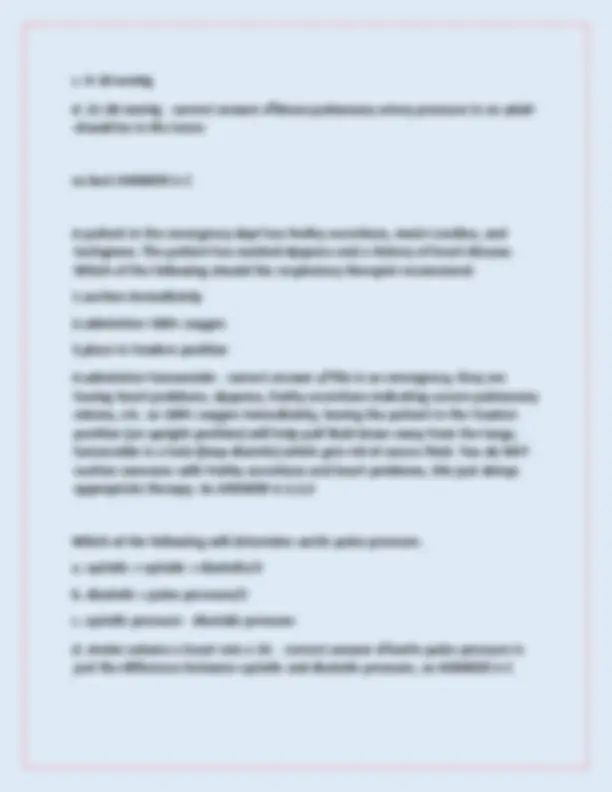
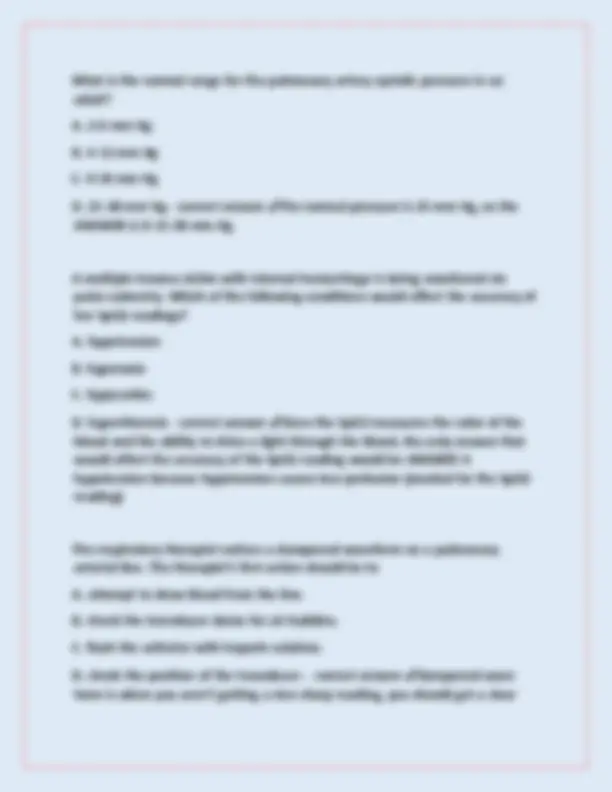
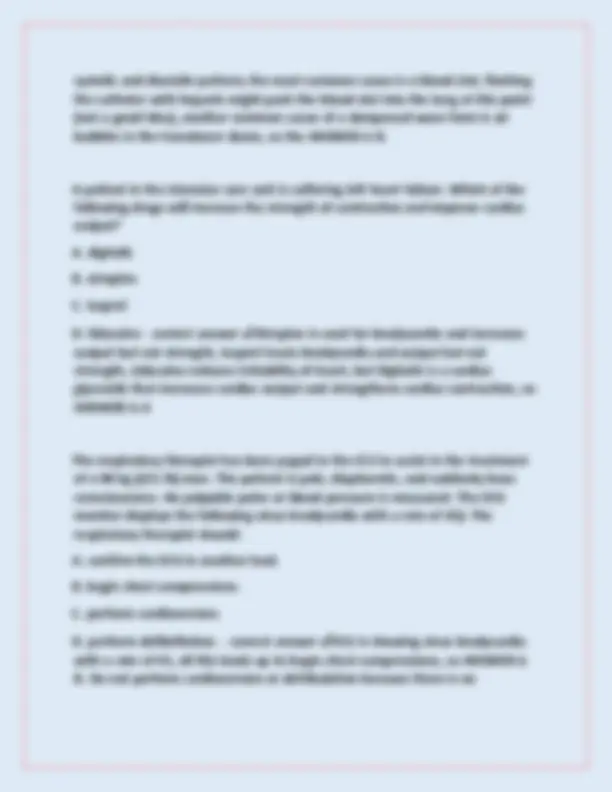
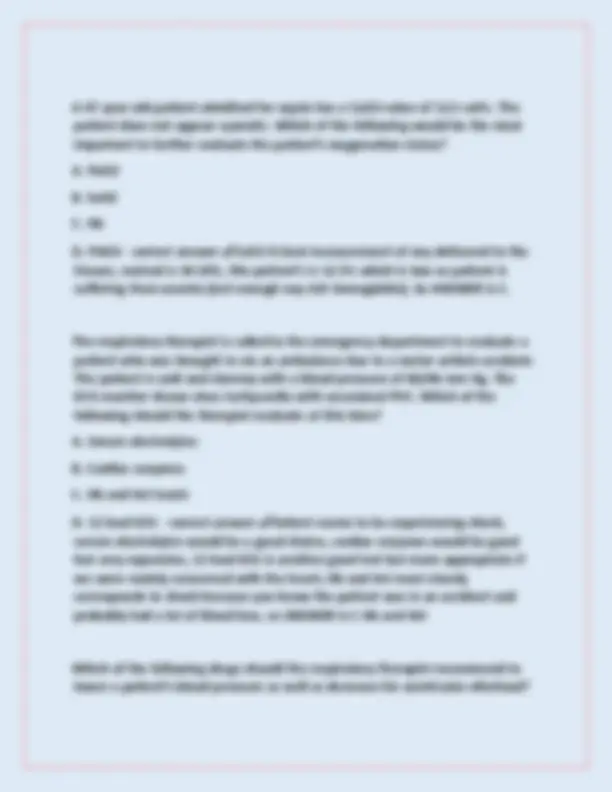
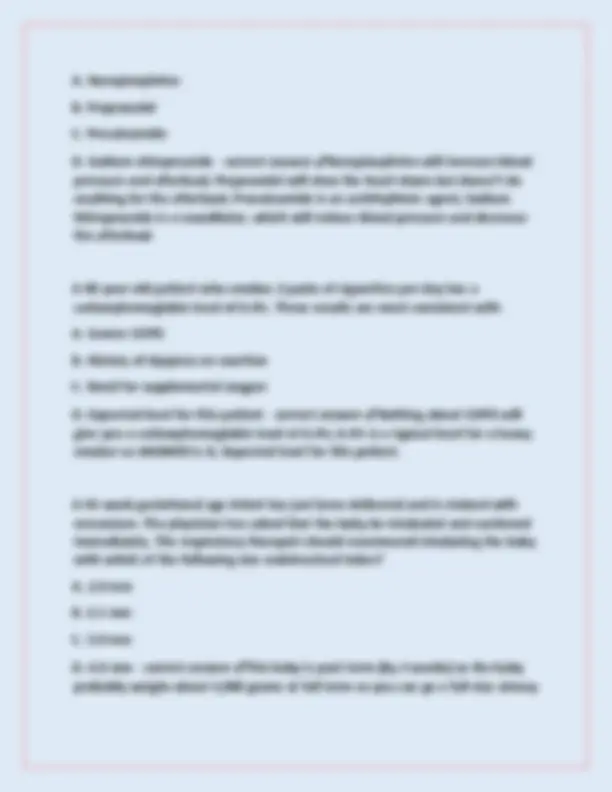
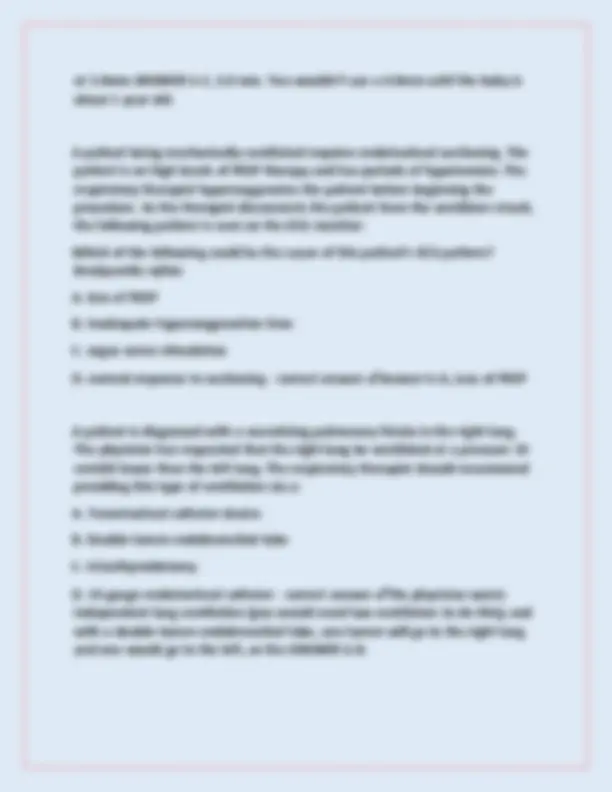
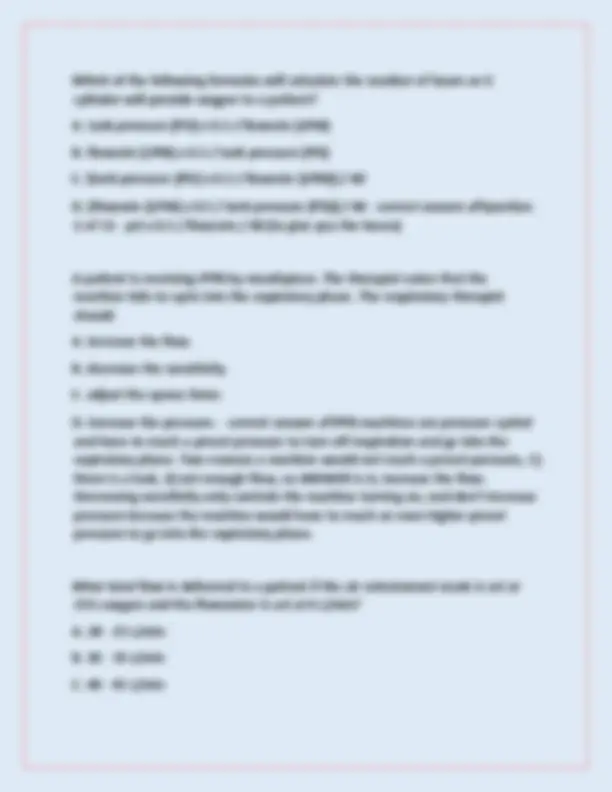
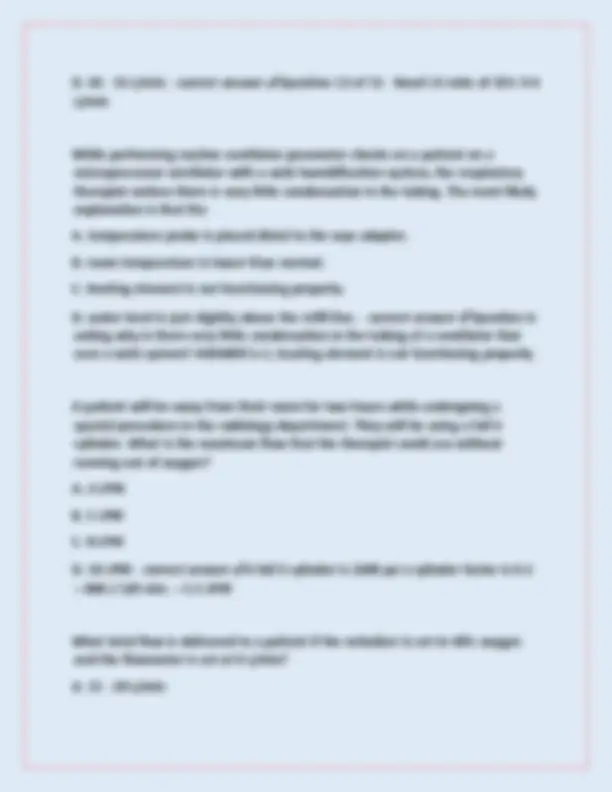
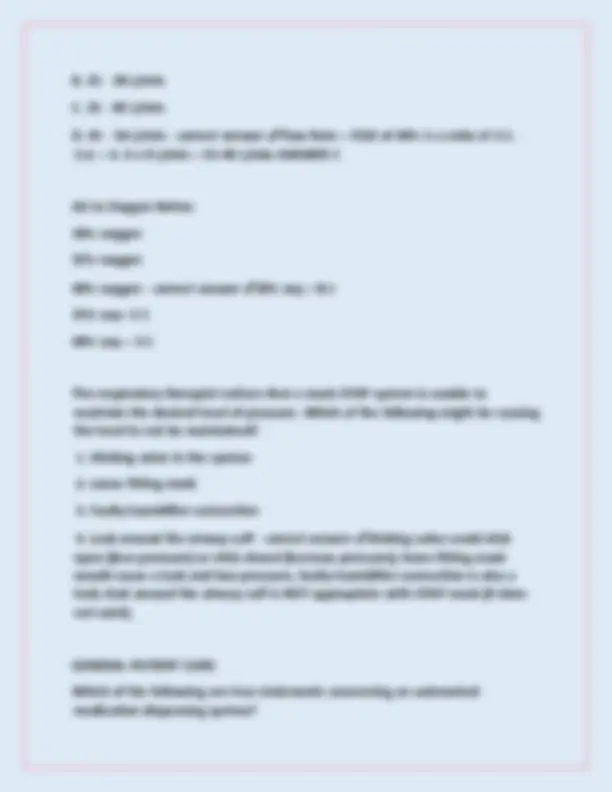
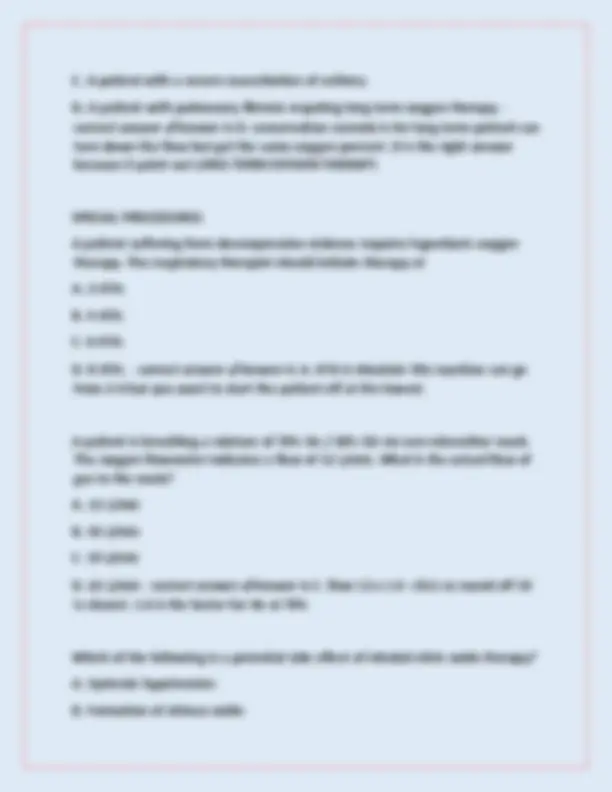
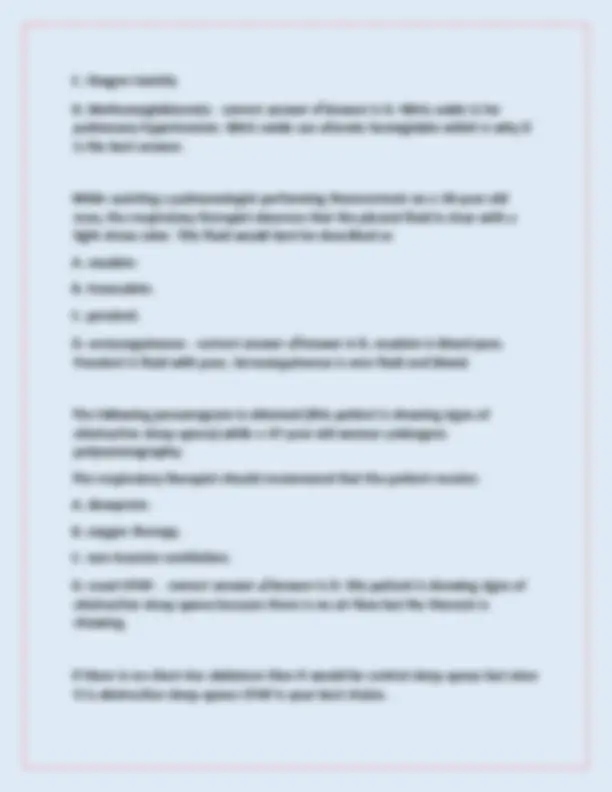
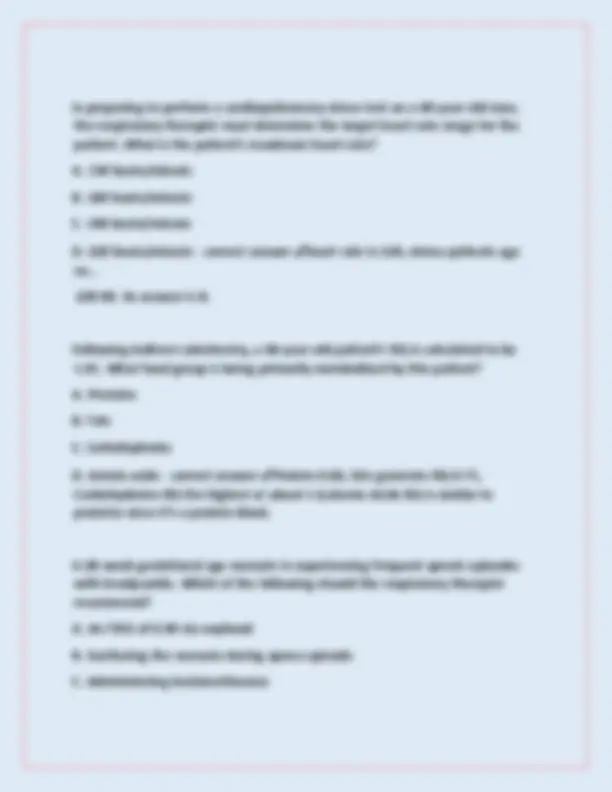
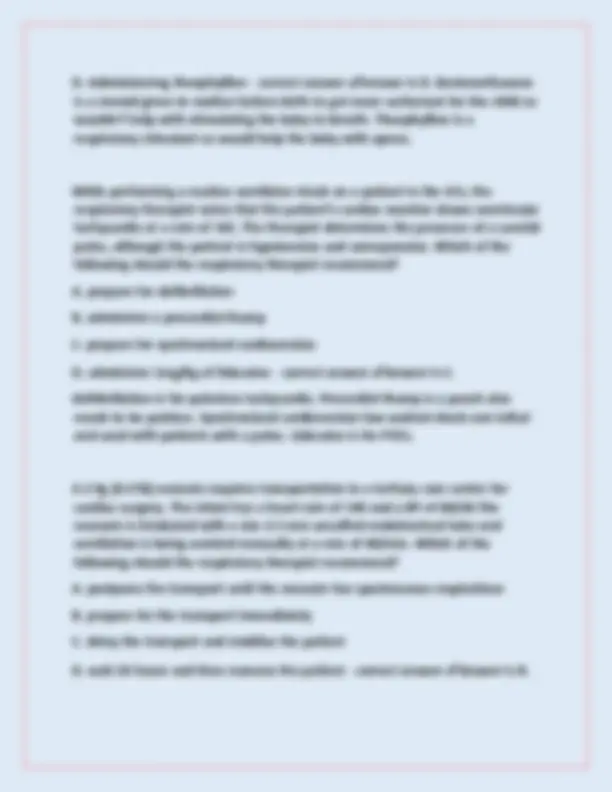
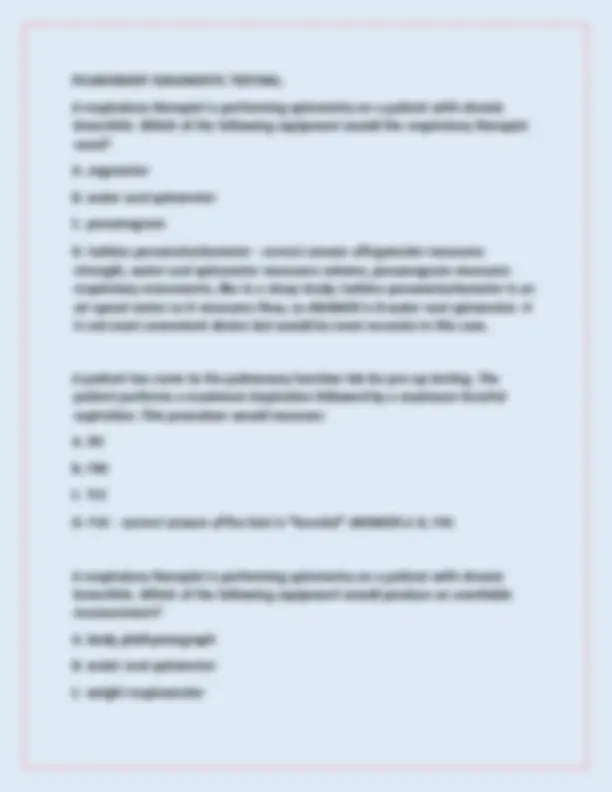
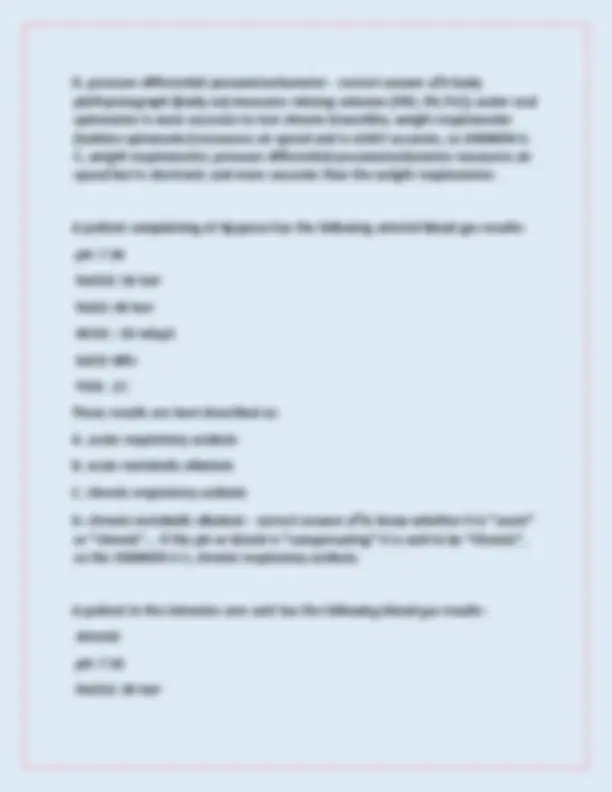
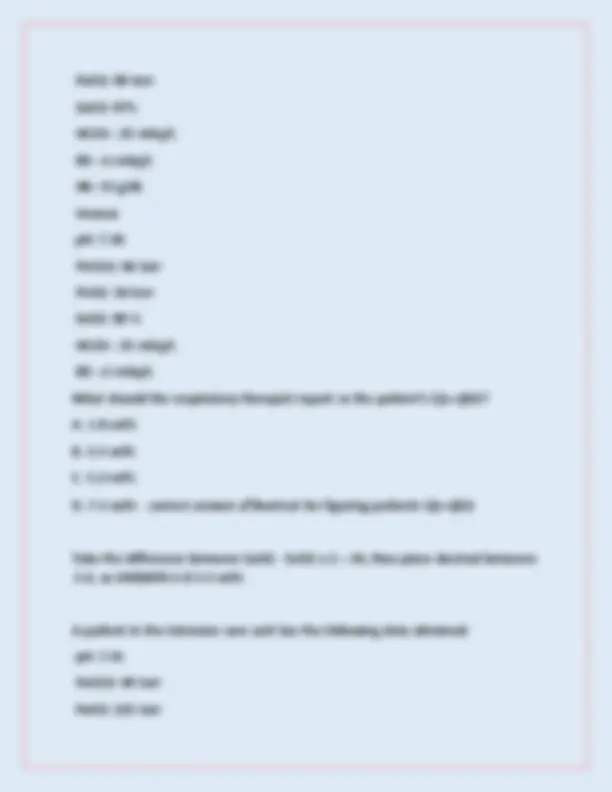
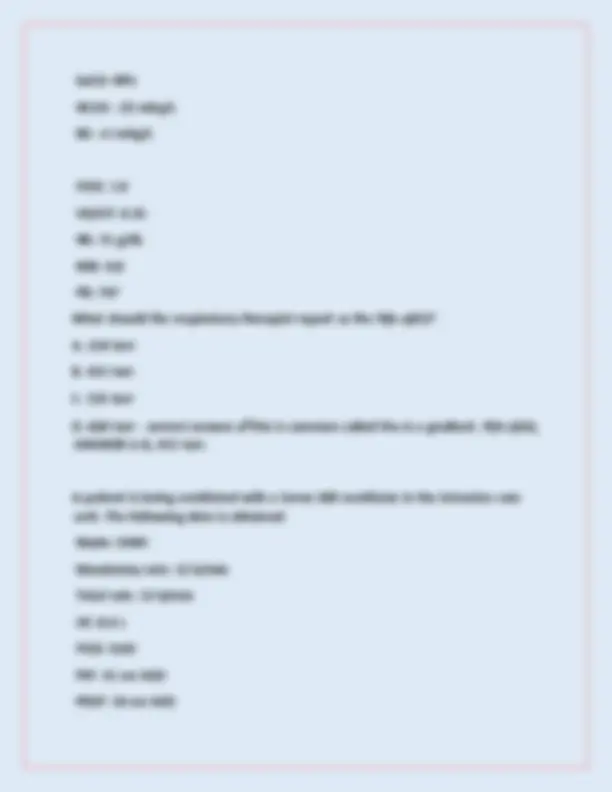
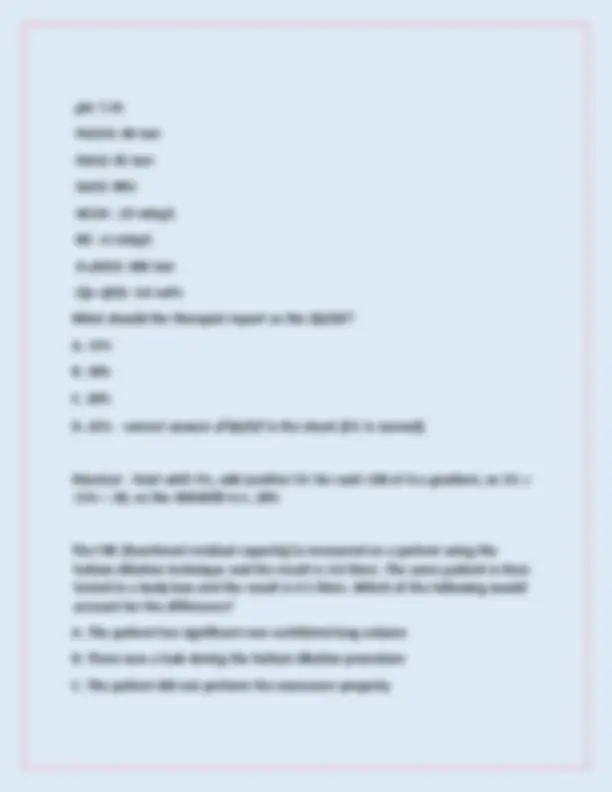
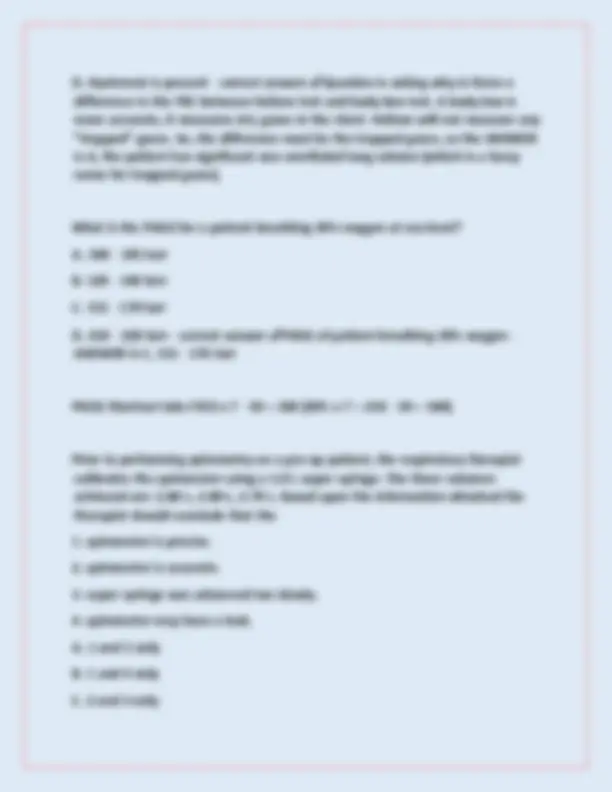
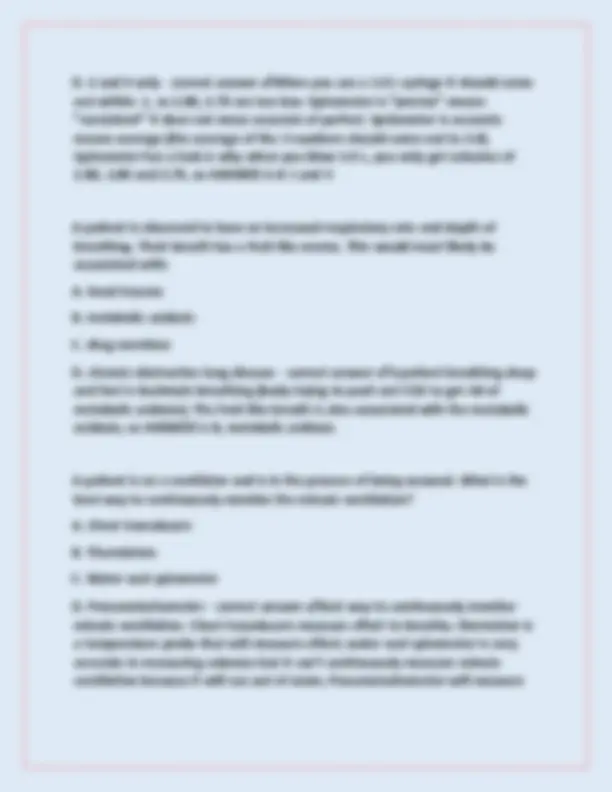
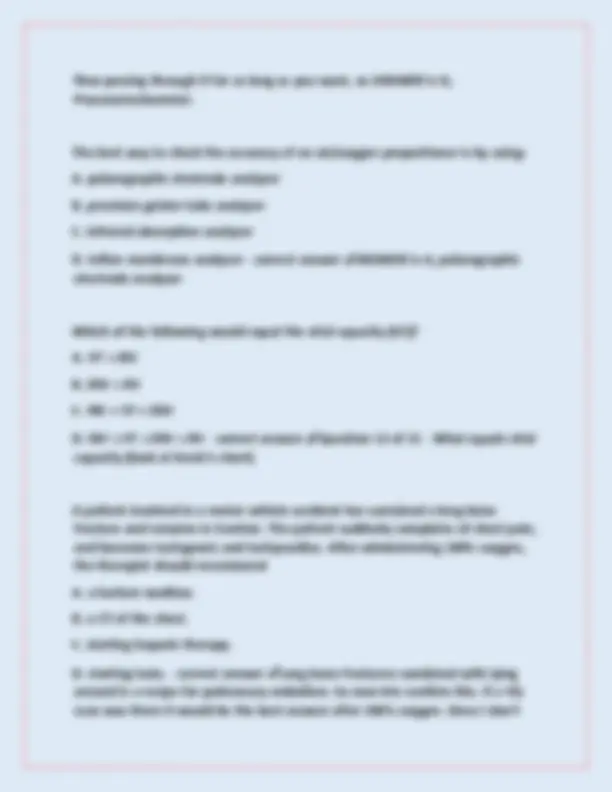
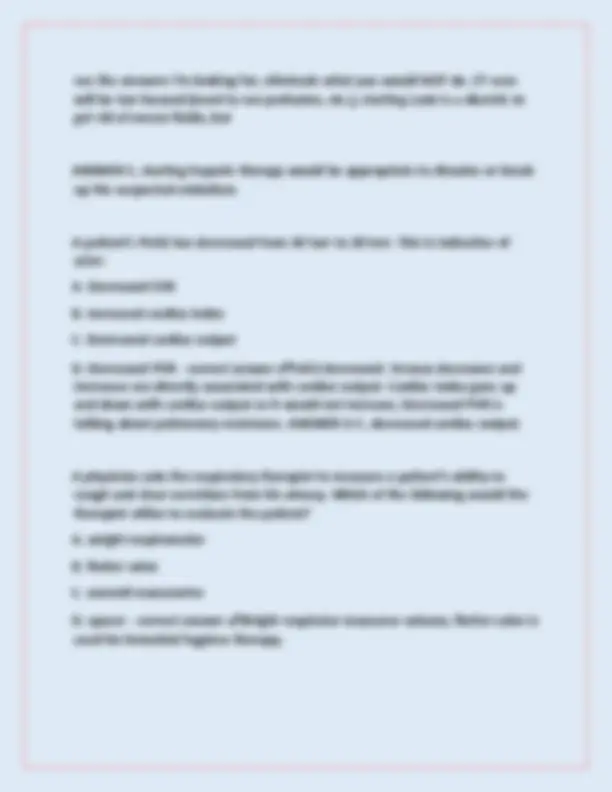
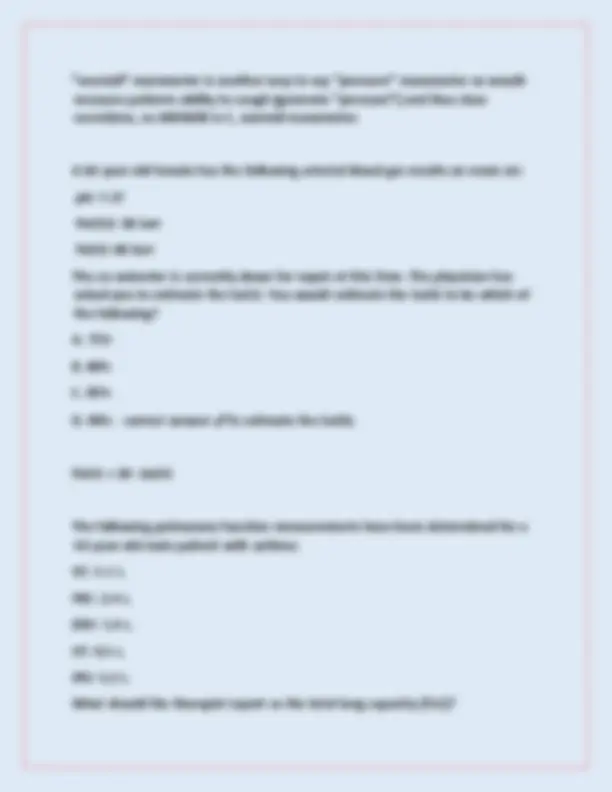
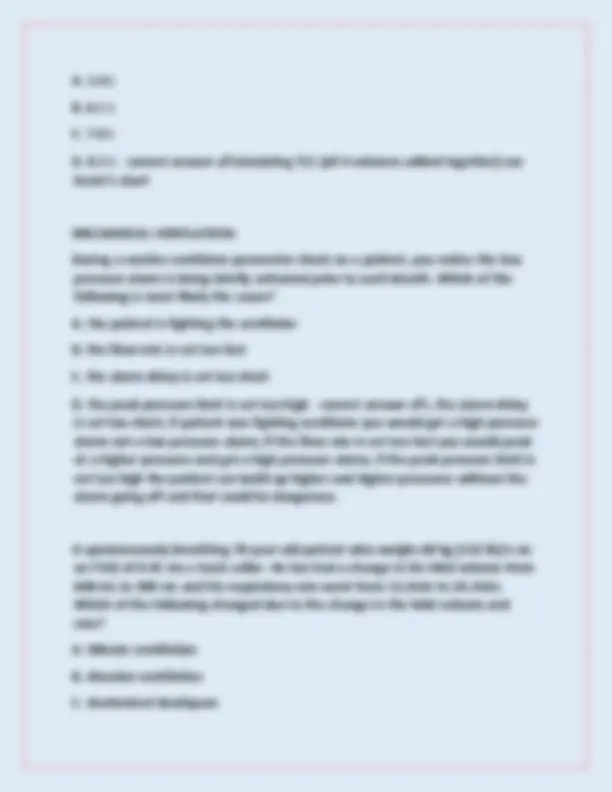
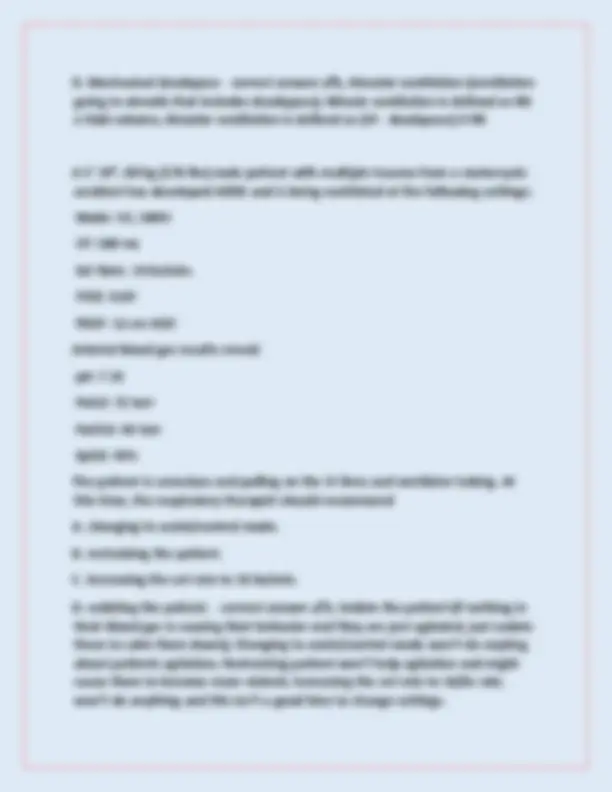
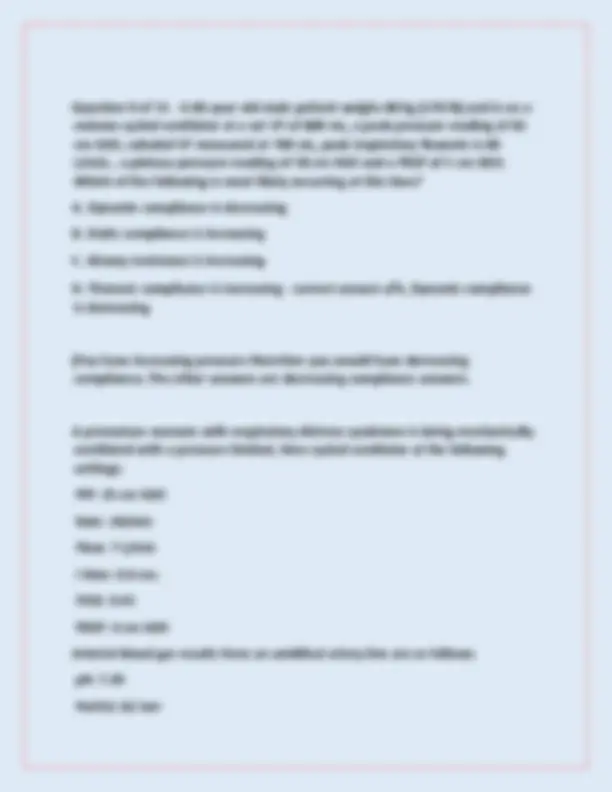
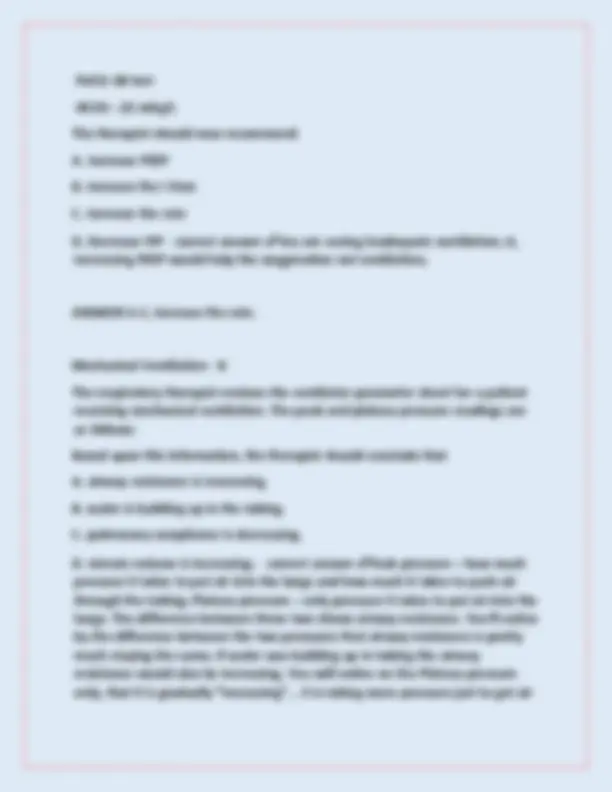
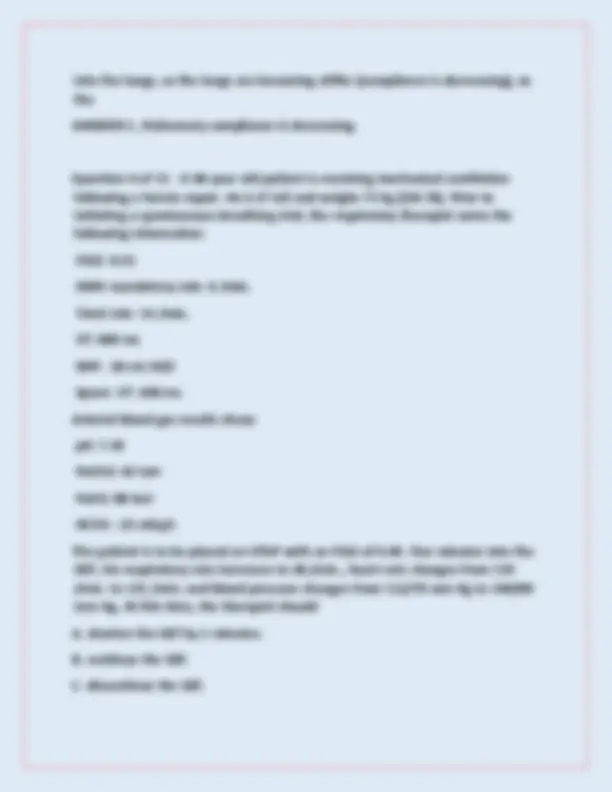
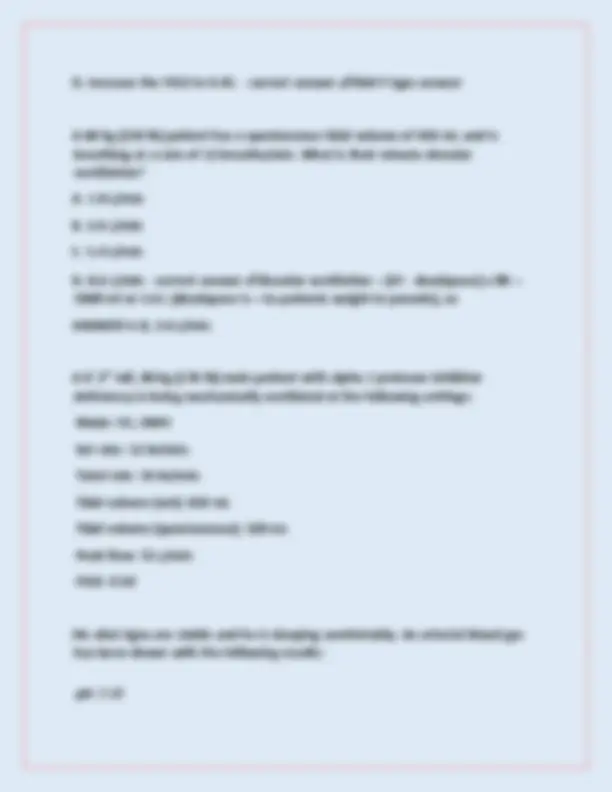
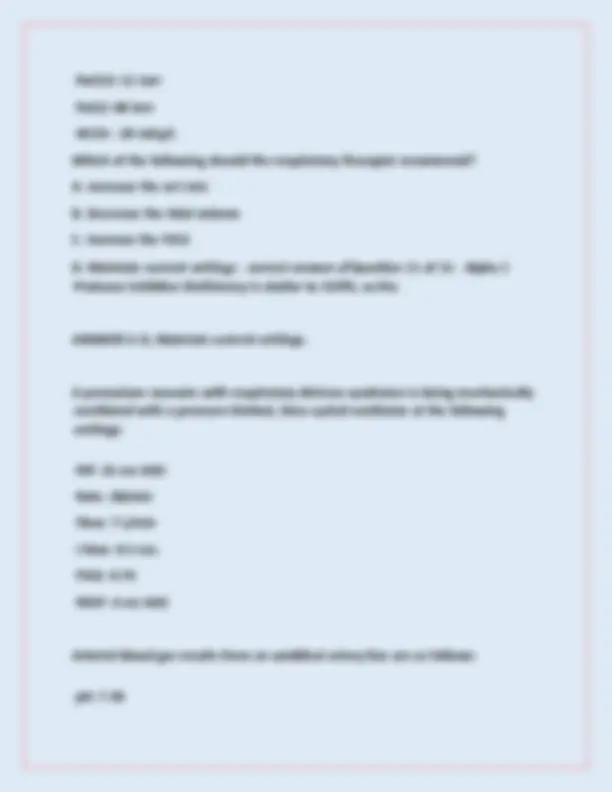
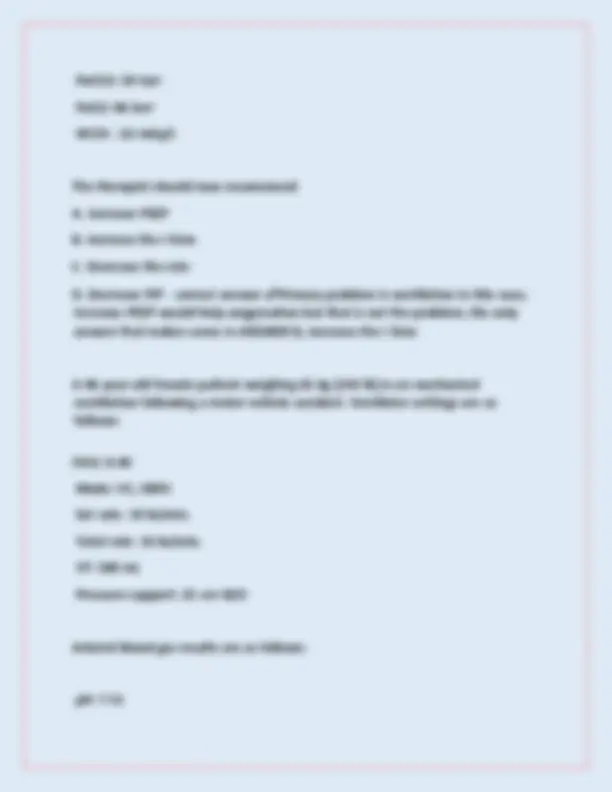
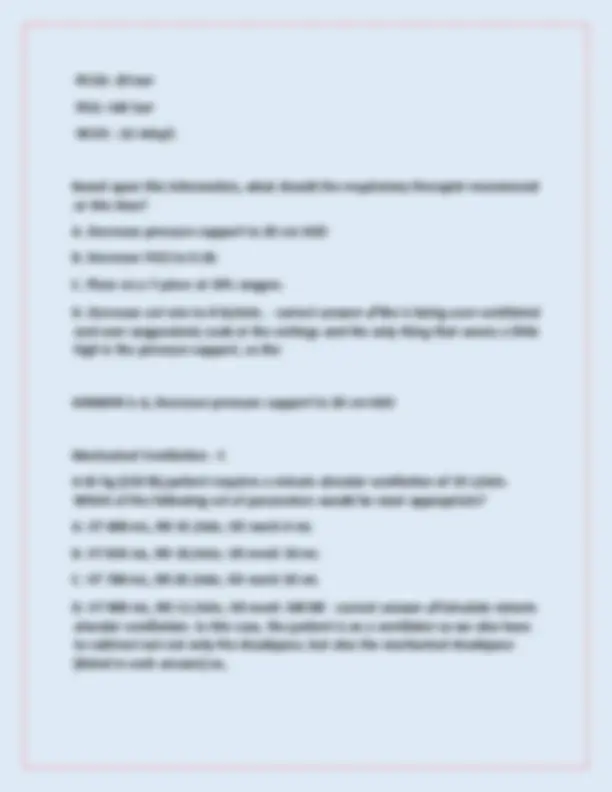
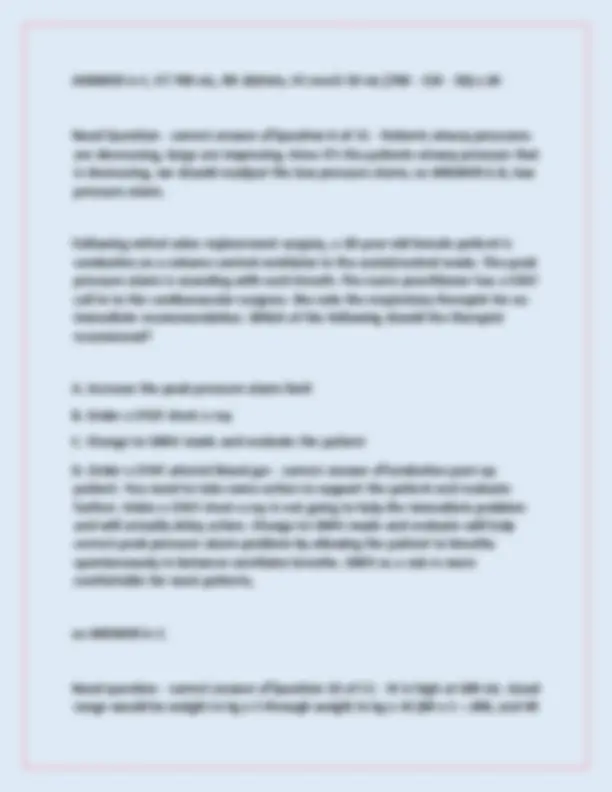
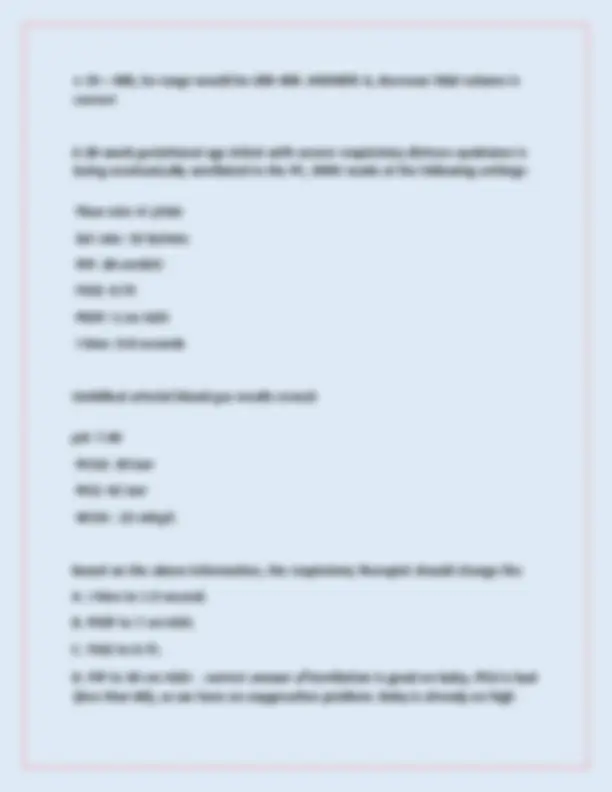
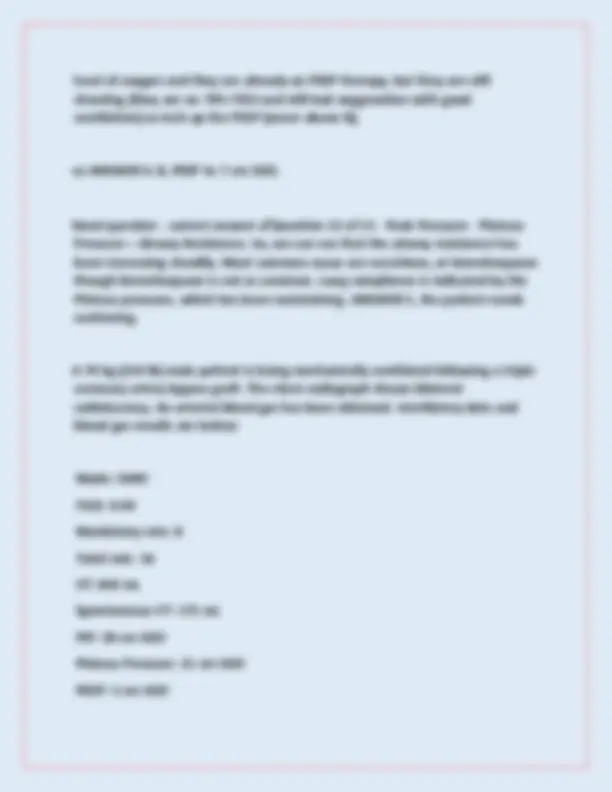
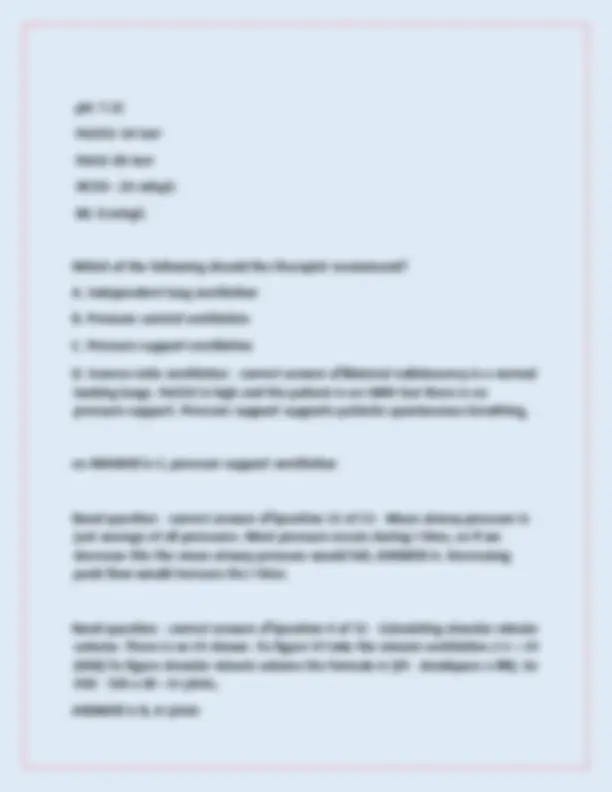
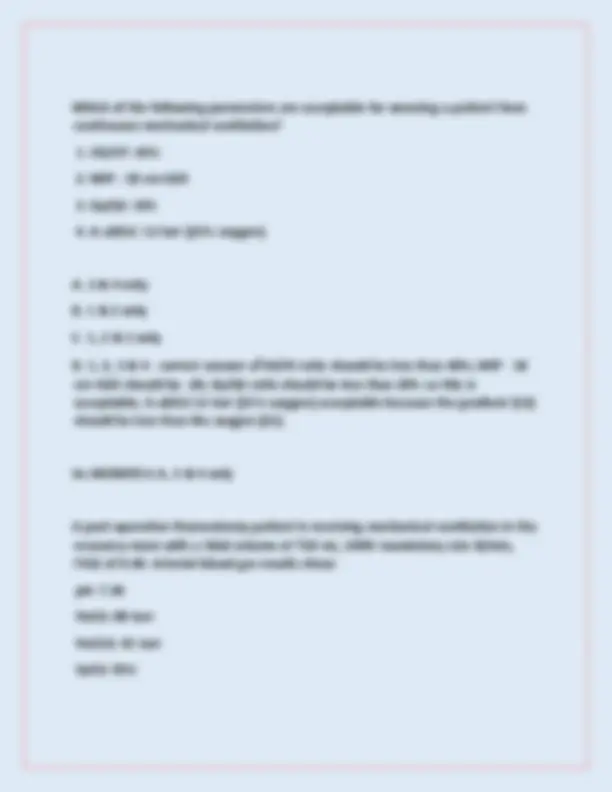
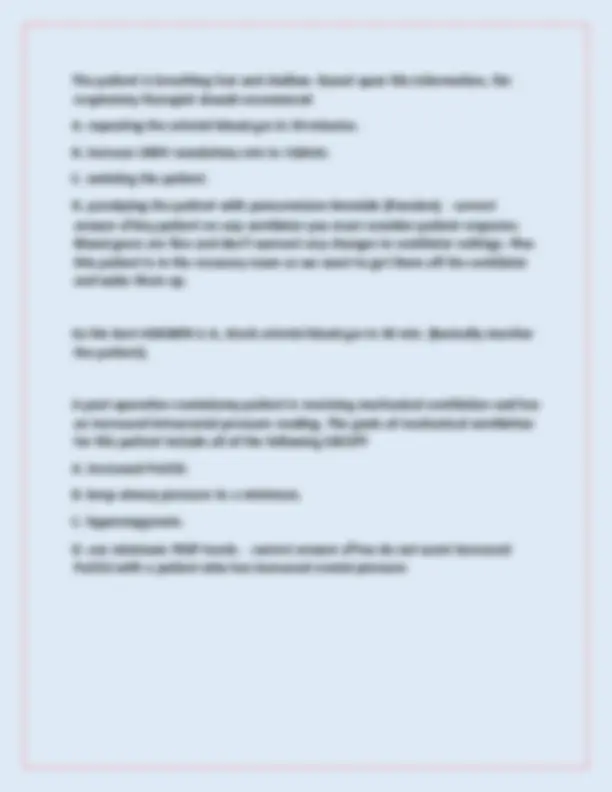


Study with the several resources on Docsity

Earn points by helping other students or get them with a premium plan


Prepare for your exams
Study with the several resources on Docsity

Earn points to download
Earn points by helping other students or get them with a premium plan
Community
Ask the community for help and clear up your study doubts
Discover the best universities in your country according to Docsity users
Free resources
Download our free guides on studying techniques, anxiety management strategies, and thesis advice from Docsity tutors
A series of multiple choice questions and answers related to respiratory therapy. It covers various topics, including static and dynamic compliance, pulmonary artery pressure, capnography, and the interpretation of vital signs. The questions are designed to test knowledge and understanding of respiratory therapy principles and procedures.
Typology: Exams
1 / 46

This page cannot be seen from the preview
Don't miss anything!







































Is |the |following |Static |OR |Dynamic |Compliance: Means |flow |throughout |the |respiratory |system |has |stopped |and |all |ventilatory |muscle |activity |is |absent. |_______ |conditions |can |be |imposed |with |an |inspiratory |pause |when |a |patient |is |sedated |and |mechanically |ventilated. |- |correct |answer |✔Static |Compliance Is |the |following |Static |OR |Dynamic |Compliance: Flow |at |airway |opening |is |zero. |Mechanics |are |evaluated |under |______ |conditions, |when |non-intubated |patient |breathes |spontaneously. |- |correct |answer |✔Dynamic |Compliance A |balloon |tipped |flow |directed |catheter |is |positioned |in |the |pulmonary |artery |with |the |balloon |deflated. |Which |of |the |following |pressures |will |be |measured |by |the |proximal |lumen: a. |Cvp b. |Pap c. |Pwp d. |Map |- |correct |answer |✔ANSWER |is |A. |Cvp |= |deflated/proximal |lumen Pap |= |deflated/distal Pwp |= |inflated/wedged
All |of |the |following |will |affect |the |accuracy |of |a |capnography |EXCEPT a. |Long |sampling |line b. |Low |sampling |flow c. |Condensation |in |the |tubing d. |Use |of |desiccant |- |correct |answer |✔Gas |will |pass |through |and |out |of |a |long |sampling |line |before |reaching |analyzer |so, |low |sampling |flow |will |not |give |you |enough |information |for |a |good |reading, |and |condensation |as |a |rule |is |always |a |problem |especially |in |analyzers. |Dessicant |removes |moisture |from |the |gas, |which |is |a |good |thing, |so | ANSWER |is |D What |should |you |recommend |FIRST |for |a |patient |with |multifocal |pvc's a. |Administration |of |lidocaine b. |Administration |of |100% |oxygen c. |Administration |of |atropine d. |Administration |of |epinephrine |- |correct |answer |✔Multiple |pvc's |coming |from |multiple |locations |(multifocal) |is |a |real |problem |and |you |should |administer |oxygen |FIRST, |so |ANSWER |is |B. |lidocaine |will |help |reduce |irritability |of |heart |and |help |with |pvc's |but |would |not |be |first |option, |atropine |is |used |for |bradycardia |and |cardiac |irregularities |but |not |pvc's, |epinephrine |is |emergency |drug |not |for |pvc's |but |more |for |pulseless |ventricular |tachycardia |or |ventricular |fibrilation |where |heart |is |not |responding |. What |is |the |normal |range |for |the |mean |pulmonary |artery |pressure |in |an |adult a. |2-6 |mm |Hg b. |4-12 |mmHg
What |is |the |normal |range |for |the |pulmonary |artery |systolic |pressure |in |an |adult? A. |2-6 |mm |Hg B. |4-12 |mm |Hg C. |9-18 |mm |Hg D. |21-28 |mm |Hg |- |correct |answer |✔The |normal |pressure |is | 25 |mm |Hg, |so |the |ANSWER |is |D |21-28 |mm |Hg A |multiple |trauma |victim |with |internal |hemorrhage |is |being |monitored |via |pulse |oximetry. |Which |of |the |following |conditions |would |affect |the |accuracy |of |her |SpO2 |readings? A. |hypotension B. |hyperoxia C. |hypocarbia D. |hyperthermia |- |correct |answer |✔Since |the |SpO2 |measures |the |color |of |the |blood |and |the |ability |to |shine |a |light |through |the |blood, |the |only |answer |that |would |affect |the |accuracy |of |the |SpO2 |reading |would |be |ANSWER |A |hypotension |because |hypotension |causes |less |profusion |(needed |for |the |SpO |reading) The |respiratory |therapist |notices |a |dampened |waveform |on |a |pulmonary |arterial |line. |The |therapist's |first |action |should |be |to A. |attempt |to |draw |blood |from |the |line. B. |check |the |transducer |dome |for |air |bubbles. C. |flush |the |catheter |with |heparin |solution. D. |check |the |position |of |the |transducer. |- |correct |answer |✔Dampened |wave |form |is |when |you |aren't |getting |a |nice |sharp |reading, |you |should |get |a |clear
|systolic |and |diastolic |pattern; |the |most |common |cause |is |a |blood |clot, |flushing |the |catheter |with |heparin |might |push |the |blood |clot |into |the |lung |at |this |point |(not |a |good |idea), |another |common |cause |of |a |dampened |wave |form |is |air |bubbles |in |the |transducer |dome, |so |the |ANSWER |is |B. A |patient |in |the |intensive |care |unit |is |suffering |left |heart |failure. |Which |of |the |following |drugs |will |increase |the |strength |of |contraction |and |improve |cardiac |output? A. |digitalis B. |atropine C. |isuprel D. |lidocaine |- |correct |answer |✔Atropine |is |used |for |bradycardia |and |increases |output |but |not |strength, |Isuprel |treats |bradycardia |and |output |but |not |strength, |Lidocaine |reduces |irritability |of |heart, |but |Digitalis |is |a |cardiac |glycoside |that |increases |cardiac |output |and |strengthens |cardiac |contraction, |so |ANSWER |is |A The |respiratory |therapist |has |been |paged |to |the |ICU |to |assist |in |the |treatment |of |a | 98 |kg |(215 |lb) |man. |The |patient |is |pale, |diaphoretic, |and |suddenly |loses |consciousness. |No |palpable |pulse |or |blood |pressure |is |measured. |The |ECG |monitor |displays |the |following |sinus |bradycardia |with |a |rate |of |45): |The |respiratory |therapist |should: A. |confirm |the |ECG |in |another |lead. B. |begin |chest |compressions. C. |perform |cardioversion. D. |perform |defibrillation. |- |correct |answer |✔ECG |is |showing |sinus |bradycardia |with |a |rate |of |45, |all |this |leads |up |to |begin |chest |compressions, |so |ANSWER |is |B. |Do |not |perform |cardioversion |or |defribulation |because |there |is |no
|mean |pressure |reading | 2 |points |below |the |PA |end-diastolic |pressure. |Based |upon |this |information, |the |therapist |should |conclude |that A. |there |is |pressure |dampening. B. |the |transducer |is |placed |too |high. C. |there |is |an |obstruction |in |the |catheter. D. |this |is |a |normal |wedge |tracing. |- |correct |answer |✔A |small |amplitude |change |is |normal |and |the |mean |pressure |reading | 2 |points |below |the |pulmonary |artery |end-diastolic |pressure |is |also |normal, |so |the |ANSWER |is |D. Methacholine |Challenge |Test | Tensilon |Challenge |Test |- |correct |answer |✔Methacholine |Challenge |Test |is |a |pulmonary |function |test |used |to |check |the |reactivity |of |a |patients |airways, |it |will |induce |bronchospasm; Tensilon |Challenge |Test |is |specifically |for |Myasthenia |Gravis, |it |helps |them |breath |right |away |but |only |lasts |a |few |minutes While |assessing |a |patient's |breath |sounds |the |respiratory |therapist |notes |that |when |the |patient |says |"ninety-nine", |it |sounds |very |loud |through |the |stethescope. |This |would |be |associated |with |which |of |the |following |conditions? A. |Pneumothorax B. |Pneumonia C. |Pleural |effusion D. |Epiglottitis |- |correct |answer |✔ 99 |is |a |sound |that |produces |vibrations |in |the |lung, |if | 99 |sounds |very |loud |through |the |stethoscope |you |know |consolidation |is |present, |so |the |ANSWER |is |B. |Pleural |effusion |you |don't |usually |hear |anything.
A |47-year-old |patient |admitted |for |sepsis |has |a |CaO2 |value |of |12.5 |vol%. |The |patient |does |not |appear |cyanotic. |Which |of |the |following |would |be |the |most |important |to |further |evaluate |the |patient's |oxygenation |status? A. |PaO B. |SaO C. |Hb D. |PAO2 |- |correct |answer |✔CaO2 |IS |best |measurement |of |oxy |delivered |to |the |tissues, |normal |is |18-20%, |this |patient's |is |12.5% |which |is |low |so |patient |is |suffering |from |anemia |(not |enough |oxy |rich |hemoglobin). |So |ANSWER |is |C. The |respiratory |therapist |is |called |to |the |emergency |department |to |evaluate |a |patient |who |was |brought |in |via |an |ambulance |due |to |a |motor |vehicle |accident. |The |patient |is |cold |and |clammy |with |a |blood |pressure |of |82/46 |mm |Hg. |The |ECG |monitor |shows |sinus |tachycardia |with |occasional |PVC. |Which |of |the |following |should |the |therapist |evaluate |at |this |time? A. |Serum |electrolytes B. |Cardiac |enzymes C. |Hb |and |Hct |levels D. | 12 |lead |ECG |- |correct |answer |✔Patient |seems |to |be |experiencing |shock, |serum |electrolytes |would |be |a |good |choice, |cardiac |enzymes |would |be |good |but |very |expensive, | 12 |lead |ECG |is |another |good |test |but |more |appropriate |if |we |were |mainly |concerned |with |the |heart; |Hb |and |Hct |most |closely |corresponds |to |shock |because |you |know |the |patient |was |in |an |accident |and |probably |had |a |lot |of |blood |loss, |so |ANSWER |is |C |Hb |and |Hct Which |of |the |following |drugs |should |the |respiratory |therapist |recommend |to |lower |a |patient's |blood |pressure |as |well |as |decrease |his |ventricular |afterload?
|at |3.0mm |ANSWER |is |C, |3.0 |mm. |You |wouldn't |use |a |4.0mm |until |the |baby |is |about | 1 |year |old. A |patient |being |mechanically |ventilated |requires |endotracheal |suctioning. |The |patient |is |on |high |levels |of |PEEP |therapy |and |has |periods |of |hypotension. |The |respiratory |therapist |hyperoxygenates |the |patient |before |beginning |the |procedure. |As |the |therapist |disconnects |the |patient |from |the |ventilator |circuit, |the |following |pattern |is |seen |on |the |ECG |monitor: Which |of |the |following |could |be |the |cause |of |this |patient's |ECG |pattern? |Bradycardia |rythm A. |loss |of |PEEP B. |inadequate |hyperoxygenation |time C. |vagus |nerve |stimulation D. |normal |response |to |suctioning |- |correct |answer |✔Answer |is |A, |Loss |of |PEEP A |patient |is |diagnosed |with |a |necrotizing |pulmonary |fistula |in |the |right |lung. |The |physician |has |requested |that |the |right |lung |be |ventilated |at |a |pressure | 10 |cmH2O |lower |than |the |left |lung. |The |respiratory |therapist |should |recommend |providing |this |type |of |ventilation |via |a: A. |Transtracheal |catheter |device B. |Double-lumen |endobronchial |tube C. |Cricothyroidotomy D. | 14 |gauge |endotracheal |catheter |- |correct |answer |✔The |physician |wants |independent |lung |ventilation |(you |would |need |two |ventilators |to |do |this); |and |with |a |double-lumen |endobronchial |tube, |one |lumen |will |go |to |the |right |lung |and |one |would |go |to |the |left, |so |the |ANSWER |is |B.
While |performing |orotracheal |intubation |for |a |patient |in |respiratory |arrest, |the |respiratory |therapist |notices |that |the |stylet |has |advanced |from |its |original |position. |The |respiratory |therapist |should A. |continue |with |the |intubation |procedure. B. |stop |the |procedure, |manually |ventilate |the |patient, |and |reposition |the |stylet. C. |retract |the |stylet |immediately. D. |remove |the |stylet |and |continue |with |the |procedure. |- |correct |answer |✔Retract |stylet |immediately...this |answer |just |stops. |But |ANSWER |B, |stop |procedure, |manually |ventilate |the |patient, |and |reposition |the |sytlet |is |the |best |"complete" |answer. Which |of |the |following |is |the |best |method |to |minimize |damage |to |the |tracheal |wall |caused |by |an |endotracheal |tube |cuff? A. |Measuring |the |volume |used |to |inflate |the |cuff B. |Palpating |the |inflation |of |the |pilot |balloon C. |Utilizing |a |cuff |pressure |manometer D. |Using |minimal |occluding |volume |to |seal |the |airway |- |correct |answer |✔Using |minimal |occluding |volume |to |seal |the |airway |is |an |older |standard |(may |be |used |in |practice |but |not |for |this |test), |so, |ANSWER |is |C, |Utilizing |a |cuff |pressure |manometer. An |H |cylinder |of |oxygen |has | 1200 |psi |remaining |in |the |tank. |How |long |will |it |take |to |decrease |to | 200 |psi |if |the |flow |is | 5 |LPM? A. | 1 |hour B. | 10 |hours C. | 60 |hours
Which |of |the |following |formulas |will |calculate |the |number |of |hours |an |E |cylinder |will |provide |oxygen |to |a |patient? A. |tank |pressure |(PSI) |x |0.3 |/ |flowrate |(LPM) B. |flowrate |(LPM) |x |0.3 |/ |tank |pressure |(PSI) C. |[tank |pressure |(PSI) |x |0.3 |/ |flowrate |(LPM)] |/ | 60 D. |[flowrate |(LPM) |x |0.3 |/ |tank |pressure |(PSI)] |/ | 60 |- |correct |answer |✔Question | 2 |of | 15 |- |psi |x |0.3 |/ |flowrate |/ | 60 |(to |give |you |the |hours) A |patient |is |receiving |IPPB |by |mouthpiece. |The |therapist |notes |that |the |machine |fails |to |cycle |into |the |expiratory |phase. |The |respiratory |therapist |should A. |increase |the |flow. B. |decrease |the |sensitivity. C. |adjust |the |apnea |timer. D. |increase |the |pressure. |- |correct |answer |✔IPPB |machines |are |pressure |cycled |and |have |to |reach |a |preset |pressure |to |turn |off |inspiration |and |go |into |the |expiratory |phase. |Two |reasons |a |machine |would |not |reach |a |preset |pressure, |1) |there |is |a |leak, |2) |not |enough |flow, |so |ANSWER |is |A, |increase |the |flow. |Decreasing |sensitivity |only |controls |the |machine |turning |on; |and |don't |increase |pressure |because |the |machine |would |have |to |reach |an |even |higher |preset |pressure |to |go |into |the |expiratory |phase. What |total |flow |is |delivered |to |a |patient |if |the |air |entrainment |mask |is |set |at |35% |oxygen |and |the |flowmeter |is |set |at | 6 |L/min? A. | 20 |- | 25 |L/min B. | 30 |- | 35 |L/min C. | 40 |- | 45 |L/min
D. | 50 |- | 55 |L/min |- |correct |answer |✔Question | 12 |of | 15 |- |Need |I:E |ratio |of |35% |X | 6 |L/min While |performing |routine |ventilator |parameter |checks |on |a |patient |on |a |microprocessor |ventilator |with |a |wick |humidification |system, |the |respiratory |therapist |notices |there |is |very |little |condensation |in |the |tubing. |The |most |likely |explanation |is |that |the A. |temperature |probe |is |placed |distal |to |the |wye |adapter. B. |room |temperature |is |lower |than |normal. C. |heating |element |is |not |functioning |properly. D. |water |level |is |just |slightly |above |the |refill |line. |- |correct |answer |✔Question |is |asking |why |is |there |very |little |condensation |in |the |tubing |of |a |ventilator |that |uses |a |wick |system? |ANSWER |is |C, |heating |element |is |not |functioning |properly. A |patient |will |be |away |from |their |room |for |two |hours |while |undergoing |a |special |procedure |in |the |radiology |department. |They |will |be |using |a |full |E |cylinder. |What |is |the |maximum |flow |that |the |therapist |could |use |without |running |out |of |oxygen? A. | 2 |LPM B. | 5 |LPM C. | 8 |LPM D. | 10 |LPM |- |correct |answer |✔A |full |E |cylinder |is | 2200 |psi |x |cylinder |factor |is |0. |= | 660 |/ | 120 |min. |= |5.5 |LPM What |total |flow |is |delivered |to |a |patient |if |the |nebulizer |is |set |to |40% |oxygen |and |the |flowmeter |is |set |at | 9 |L/min? A. | 15 |- | 20 |L/min
D. |intubating |the |patient |with |a |Carlens |tube. |- |correct |answer |✔Answer |is |C. |Prone |position |is |good |which |is |what |I |picked |but |not |the |nest |answer. |The |most |important |is |making |sure |the |suction |catherter |is |enclosed. A |75-year-old |patient |with |COPD |is |receiving |oxygen |at |home |by |nasal |cannula |with |a |bubble |humidifier. |How |should |the |respiratory |therapist |instruct |the |patient |to |clean |his |humidifier? A. |Place |it |on |the |top |shelf |of |the |dishwasher. B. |Soak |it |in |an |acetic |acid |solution |for | 20 |minutes |and |rinse |with |water. C. |Rinse |it |with |distilled |water |and |allow |to |air |dry. D. |Soak |it |in |an |alkaline |glutaraldehyde |solution |for | 30 |minutes |and |rinse |with |water. |- |correct |answer |✔Answer |is |B. |Dishwasher |would |ruin |it |by |the |heat. |Answer |d |would |sterilize |it |but |to |expensive |and |not |practical |for |home |setting. In |order |to |monitor |compliance |of |hospital |employees |in |a |smoking |cessation |program, |the |respiratory |therapist |should |monitor |the |employees' A. |PaO2. B. |FECO. C. |PETCO2. D. |FENO. |- |correct |answer |✔Answer |is |B. |FEC0 |is |high |means |they |have |been |smoking |shows |the |carbon |monoxide |levels. |It's |the |exhaled |c0 |levels. An |oxygen |conservation |cannula |would |be |most |appropriate |for |which |of |the |following |patients? A. |A |patient |with |pneumonia |requiring |low |flow |oxygen. B. |A |patient |with |emphysema |who |is |experiencing |increased |shortness |of |breath.
C. |Oxygen |toxicity D. |Methemoglobinemia |- |correct |answer |✔Answer |is |D. |Nitric |oxide |is |for |pulmonary |hypertension. |Nitric |oxide |can |alterate |hemoglobin |which |is |why |D |is |the |best |answer. While |assisting |a |pulmonologist |performing |thoracentesis |on |a |58-year-old |man, |the |respiratory |therapist |observes |that |the |pleural |fluid |is |clear |with |a |light |straw |color. |This |fluid |would |best |be |described |as A. |exudate. B. |transudate. C. |purulent. D. |serosanguineous |- |correct |answer |✔Answer |is |B. |exudate |is |blood |puss. |Purulent |is |fluid |with |puss. |Serosanguineous |is |sero |fluid |and |blood. The |following |pneumogram |is |obtained |(this |patient |is |showing |signs |of |obstructive |sleep |apnea) |while |a |47-year-old |woman |undergoes |polysomnography: The |respiratory |therapist |should |recommend |that |the |patient |receive: A. |doxapram. B. |oxygen |therapy. C. |non-invasive |ventilation. D. |nasal |CPAP. |- |correct |answer |✔Answer |is |D. |this |patient |is |showing |signs |of |obstructive |sleep |apnea |because |there |is |no |air |flow |but |the |thoracic |is |showing. | If |there |is |no |chest |rise |abdomen |then |it |would |be |central |sleep |apnea |but |since |it |is |obstructive |sleep |apnea |CPAP |is |your |best |choice.
In |preparing |to |perform |a |cardiopulmonary |stress |test |on |a |60-year-old |man, |the |respiratory |therapist |must |determine |the |target |heart |rate |range |for |the |patient. |What |is |the |patient's |maximum |heart |rate? A. | 130 |beats/minute B. | 160 |beats/minute C. | 190 |beats/minute D. | 220 |beats/minute |- |correct |answer |✔heart |rate |is |220, |minus |patients |age |so... |220-60. |So |answer |is |B. Following |indirect |calorimetry, |a |66-year-old |patient's |RQ |is |calculated |to |be |1.01. |What |food |group |is |being |primarily |metabolized |by |this |patient? A. |Proteins B. |Fats C. |Carbohydrates D. |Amnio |acids |- |correct |answer |✔Protein |0.82, |fats |generate |RQ |0.71, |Carbohydrates |RQ |the |highest |at |about |1.0,Amnio |Acids |RQ |is |similar |to |proteins |since |it's |a |protein |block. A |28-week |gestational |age |neonate |is |experiencing |frequent |apneic |episodes |with |bradycardia. |Which |of |the |following |should |the |respiratory |therapist |recommend? A. |An |FIO2 |of |0.40 |via |oxyhood B. |Suctioning |the |neonate |during |apnea |episode C. |Administering |beclomethasone